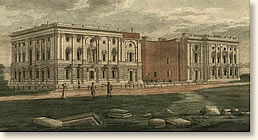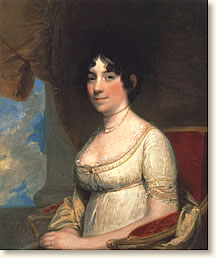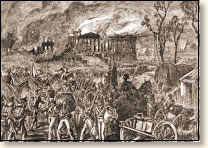The article from EyeWitness to History.com gives a brief summary of what led up to the August 24th 1814 invasion of Washington. The article also describes the setting of this invasion. Following this introduction, EyeWitness to History provides a primary account of the attack on Washington D.C. This account is about the British invasion from the viewpoint of a British soldier. It contains some very interesting information. It describes how General Ross sent a party to Washington to make a truce of some kind, but this party was fired upon from a house as they entered the city. In this attack the horse of General Ross himself was killed. Gleig then accounts how the British responded to this violation of ethics by killing those in the house and then proceeding "to burn and destroy everything in the most distant degree connected with government." Gleig explains that the British destroyed the Capital Building, White House, a dockyard, arsenal, barracks, a brand new frigate, and many other things connected with the government. He also explains how the British soldiers who invaded the White House ate a feast that had been prepared for the President himself.
 |
| From: EyeWitness to History.com |
The context of this writing was the attack on Washington D.C on August 24, 1814. This attack occurred within the larger context of the war of 1812. Again, the two possibilities that I see for the purpose of this source are either documentation for official British records, or simply informal documentation for personal reasons. In my very uninformed opinion, I would guess that it is the later.
My second primary source is also from EyeWitness to History.com. This primary source is a letter by Dolly Madison to her sister about the days just prior to the British taking the White House. This letter accounts her expectant waiting for her husband, President Madison and her eventual departure from the White House.
 |
| From: EyeWitness to History.com |
Dolly Madison, the wife of President James Madison, is the author of this letter. I am unsure of her motivation because I do not know when this was written. If the letter was written during the events described in 1814, then Dolly's purpose was to keep her sister informed about what was going on concerning her safety and whereabouts. However, EyeWitness to History seems to indicate that this letter was written years after the fact. The letter is introduced on the website with "Some years later, Dolley Madison recreated the scene at the White House that day in a letter to her sister."(EyeWitness to History.com) If this letter was indeed written years after the fact, the purpose could have been to simply share her experience of the event with her sister or to give her sister a dramatized account of the moments before the British invaded Washington.
If this letter was written during the events described, then the context is the War of 1812, specifically the British invasion of Washington on August 24, 1814. The letter would have been written to inform Dolly's sister of Dolly's health and where she was headed. However, if the letter was written years after the fact, the context changes. If it was written years after the fact, then I am unsure of what the context was because I do not know when it was written. If this was the case, I would also be unsure of what led this source to be written.
Sources: "The British Burn Washington, DC, 1814," EyeWitness to History, eyewitnesstohistory.com (2003).
"Dolley Madison Flees the White House, 1814" EyeWitness to History, www.eyewitnesstohistory.com (2009).
